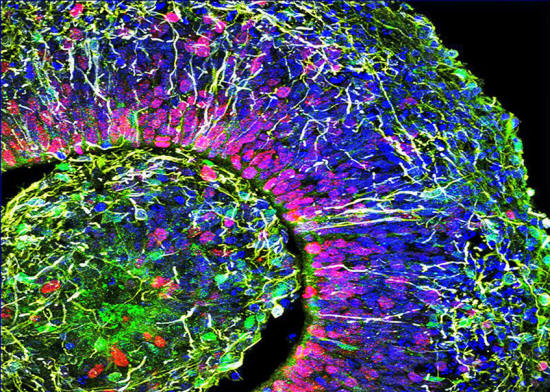|
from Nature Website
shows more mature cortical neurons on the outer edge of the structure.
Credit:
Muotri Lab/UC San Diego
to study the early stages of brain development disorders, including epilepsy.
Research in this area has been slow, partly because it is difficult to obtain fetal-tissue samples for analysis and nearly impossible to examine a fetus in utero.
Many researchers are excited about the promise of these 'organoids', which, when grown as 3D cultures, can develop some of the complex structures seen in brains.
But the technology also
raises questions about the ethics of creating miniature
organs that could develop 'consciousness' (self-awareness.)
They grew hundreds of brain organoids in culture for 10 months, and tested individual cells to confirm that they expressed the same collection of genes seen in typical developing human brains. 1
The group presented the work at the Society for Neuroscience meeting in San Diego this month.
By six months, the
organoids were firing at a higher
rate than other brain organoids previously created, which surprised
the team.
When the researchers compared these rhythms to the EEGs of premature babies, they found that the organoids' patterns mimicked those of infants born at 25-39 weeks post-conception.
But his group is now working to grow the organoids for longer to see whether they will continue to mature.
The researchers also plan to explore whether these structures function like a normal cortex by hooking them up to organoids that simulate other parts of the brain or body.
Although the work is
preliminary, he adds, the similarities to preterm infant EEG
patterns suggest that the organoids could eventually be useful for
studying brain-development disorders, such as epilepsy or autism.
Just because the
organoids' brain waves look like those in premature babies doesn't
mean they're doing the same thing, says Sampsa Vanhatalo, a
neurophysiologist at the University of Helsinki who developed the
database of infant EEGs to which Muotri compared measurements from
his organoids.
The organoids could be missing key components that drive EEG patterns in real brains, he adds.
But he acknowledges that
it could be difficult to know when an organoid is conscious,
since researchers don't even agree on how to measure
consciousness in adults, or on when it appears in infants.
References
|


